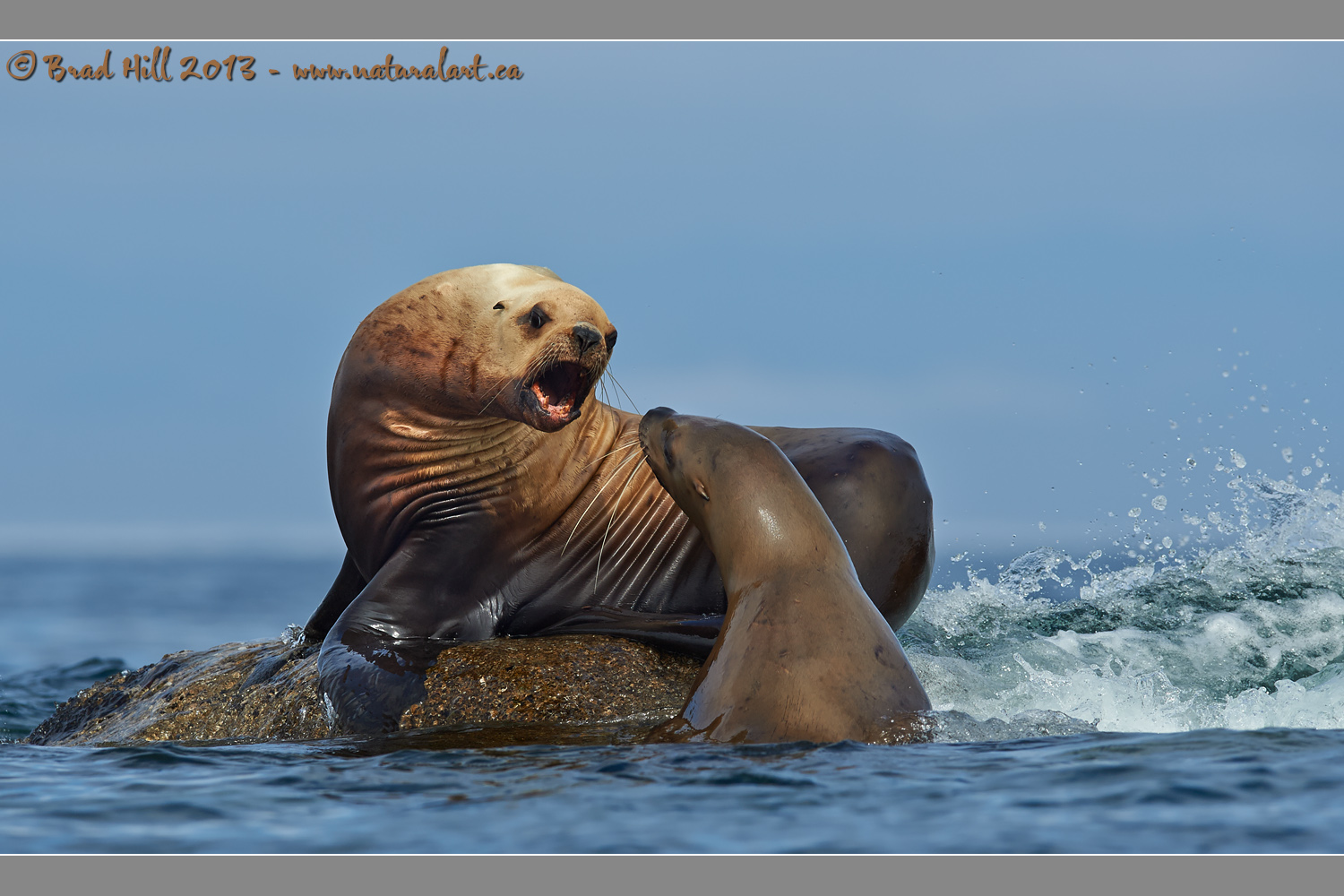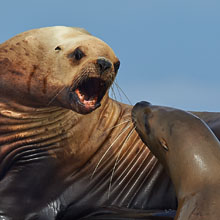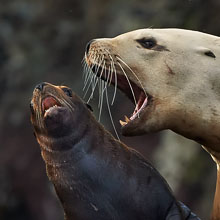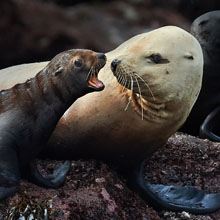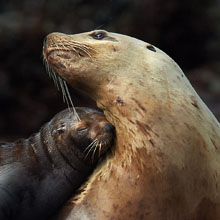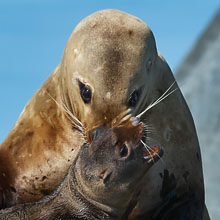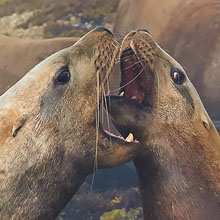Availability: Undetermined - Enquiries?
In the Field
MY Rock! Northern Vancouver Island, BC, Canada. August 20, 2012
Steller Sea Lions are gregarious animals that are often found in large groups on what are known as "haul out rocks". Any animal who spends time around others of its own species has to figure out how to interact with them in a diversity of situations. Just being in very close proximity on rocks pretty much ensures that sea lions will spend a lot of time interacting. Add in the effect of shrinking real estate due to rising tide water and...well...you can pretty much guarantee you're going to see a LOT of intraspecific interactions with sea lions.
About 20 minutes before I shot this image the rock shown was high enough out of the water that there was room for 5 sea lions on it. But, as the water rose minute-by-minute there was less and less room on the rock, and one-by-one the lowest ranking sea lion got kicked off the rock by one of his or her so-called "buddies"! By the time I captured this shot there was room for only ONE sea lion on the rock, and, despite the pleas of this smaller female, she wasn't too interested in sharing it! It was great fun watching the series of interactions on this rock, and even MORE fun photographing it!
Here's a higher resolution (2400 pixel) version of this mouthy sea lion:
• MY Rock! Download 2400 pixel image (JPEG: 1.0 MB)
ADDITIONAL NOTES:
1. This image - in all resolutions - is protected by copyright. I'm fine with personal uses of it (including use as desktop backgrounds or screensavers on your own computer), but unauthorized commercial use of the image is prohibited by law. Thanks in advance for respecting my copyright!
2. Like all wildlife photographs on this website, this image was captured following the strict ethical guidelines described in The Wildlife FIRST! Principles of Photographer Conduct. I encourage all wildlife photographers to always put the welfare of their subjects above the value of their photographs.
3. This image was captured during my "Humpback, Orcas, Sea Lions & More" photo tour in August of 2012. Each year I offer trips into two different parts of the Great Bear Rainforest as well as one to photograph aquatic mammals and oceanscapes near the northern tip of Vancouver Island. And, in selected years, I also offer photo tours to locations to capture other highly sought-after subjects, such as various owl species of the boreal forest and wildlife of Canada's Arctic. Details about these trips can be found on the Photo Tours page of this website.
Behind the Camera
MY Rock! Northern Vancouver Island, BC, Canada. August 20, 2012
Digital Capture; Compressed RAW (NEF) 14-bit format; ISO 200.
Nikon D4 paired with Nikkor 400mm f2.8 VRII prime lens - hand-held from floating Zodiac. VR on and in normal mode.
1/1600s @ f5.6; -0.67 stop compensation from matrix-metered exposure setting. Auto ISO engaged (with shutter speed set to 1/1600s).
At the Computer
MY Rock! Northern Vancouver Island, BC, Canada. August 20, 2012
RAW Conversion to 16-bit TIFF, including first-pass/capture sharpening using Capture One Pro version 7. Three raw variants (processed from raw) differing by a total of 0.5 stops in exposure.
Further digital corrections on resulting 16-bit TIFF files using Adobe's Photoshop CS6 and Light Craft's Lightzone. Photoshop adjustments included compositing the raw conversion exposure variants, selective minor tweaks to exposure, selective colour saturation and desaturation, and selective sharpening for web output. Final tone tweaking performed using tonemapper/re-light tool in Lightzone.
Conservation
MY Rock! Northern Vancouver Island, BC, Canada. August 20, 2012
Ten percent of the revenue generated by this image will be donated to Raincoast*.
Species Status in Canada**: Special Concern (November 2003) - protected in Canada since 1970.
The Steller's Sea-Lion (Eumetopias jubatus) is the largest of the sea-lions, and males can weigh up to a ton (females are considerably smaller and rarely weigh over 600 lb). Males compete among themselves for females, and successful males end up breeding with several females within their harem.
From the early 1900's through to the 1970's huge numbers of Steller's Sea-Lions were culled for their fur and to remove a competitor (for humans) for salmon. During that time approximately 55,000 sea lions were killed and the breeding population of BC was lowered to about 4,000 animals. Since the Steller Sea Lion first received protection in 1970 the population in the coastal waters of BC has grown to between 18,000 to 19,700 animals (7,600 or so of these are of breeding age).
*The Raincoast Conservation Society (and Foundation) is an effective and efficient organization that has been fighting for protection of this unique habitat. If you are looking for a meaningful way to contribute to the conservation of this amazing ecosystem, Raincoast will provide maximal "bang" for your conservation dollars.
**as determined by COSEWIC: The Committee on the Status of Endangered Wildlife in Canada












